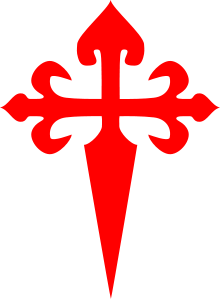Juan de Borja y Castro

Juan de Borja y Castro (1533,
Biography
Family origins and early life
Juan was the third son of
Between 1539 and 1543, he lived with family members in
Juan was educated amongst the
After the death of his mother in 1546, from 1550-51, he accompanied his father to
Diplomat and Soldier
After entering the service of Philip II of Spain as a staff member for Prince Carlos, he became a soldier at Gipuzkoa, where under the command of the contemporary Viceroy of Navarre, Vespasiano I Gonzaga, he took part in the defense of the province against the French during the Italian Wars.
His diplomatic career began in 1569 when he was sent to
In 1576, he went to Prague as the Spanish ambassador to Emperor Rudolph II of the Holy Roman Empire. He maintained this position until 1581, the same year in which he published his only known literary work, "Empresas Morales".[1]
At the Spanish court
After returning to Spain, he was named head
Death and legacy

Juan died at the age of 73 in September 1606, the victim of an accident which occurred when the litter basket in which he was carried, due to his suffering from gout, fell down a staircase at El Escorial. His body was initially buried at the Colegio Imperial de Madrid until 1613, when it was transferred to the Church of Saint Roch in Lisbon, Portugal.[4]
Marriage and Descendants
In 1552, Juan returned to Gandia and married Lorenza de Oñaz y Loyola, the niece of Ignatius of Loyola. The pair would have the following children:[2]
- Eleanor, who married Pedro de Borja.
- Magdelena, who married John Urban.
- Francisa, who joined a convent.
- Juana, who joined a convent.
After the death of his first wife in 1575, he married again, with Francisca de Aragón Barreto. The pair would have the following children:
- Viceroy of Peru.
- Antonio de Borja y Aragón, who joined the clergy.
- Rodrigo de Borja y Aragón, who died in infancy.
- Carlos de Borja y Aragón, who married the Duchess of Villahermosa.
- Fernando de Borja y Aragón, who was the viceroy of Valencia and Aragon.
References
- ISBN 84-89747-41-5) (in Spanish)
- ^ a b Rafael García Mahíques, Juan de Borja y el universo cultural de la emblemática Archived 2016-03-05 at the Wayback Machine (in Spanish)
- ISBN 84-89512-34-5), pp. 75-76 (in Spanish)
- ^ Luis Cabrera de Córdoba, Relaciones de las cosas sucedidas en la corte de España, desde 1599 hasta 1614, pp. 269, 287-288 (in Spanish)
